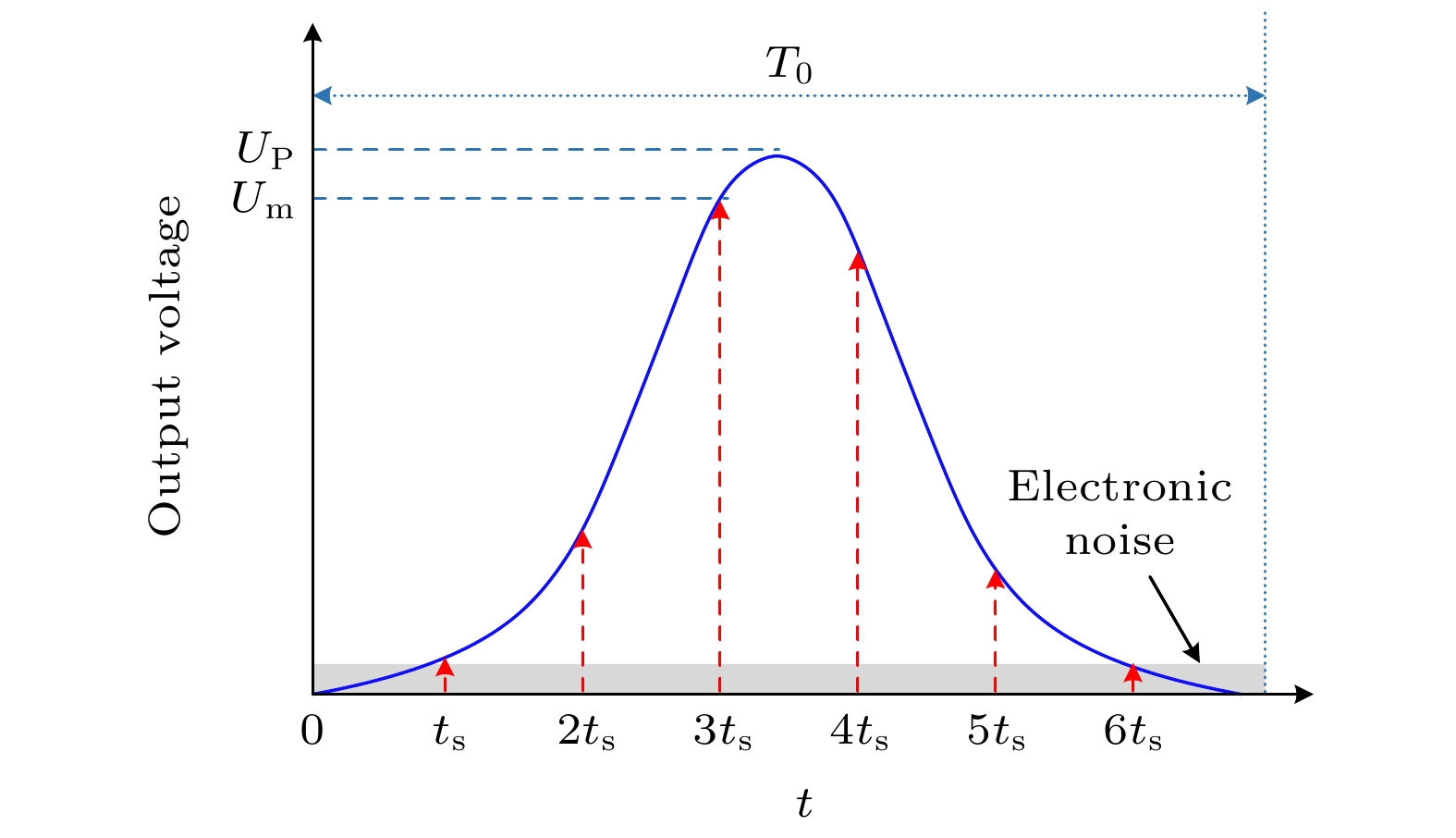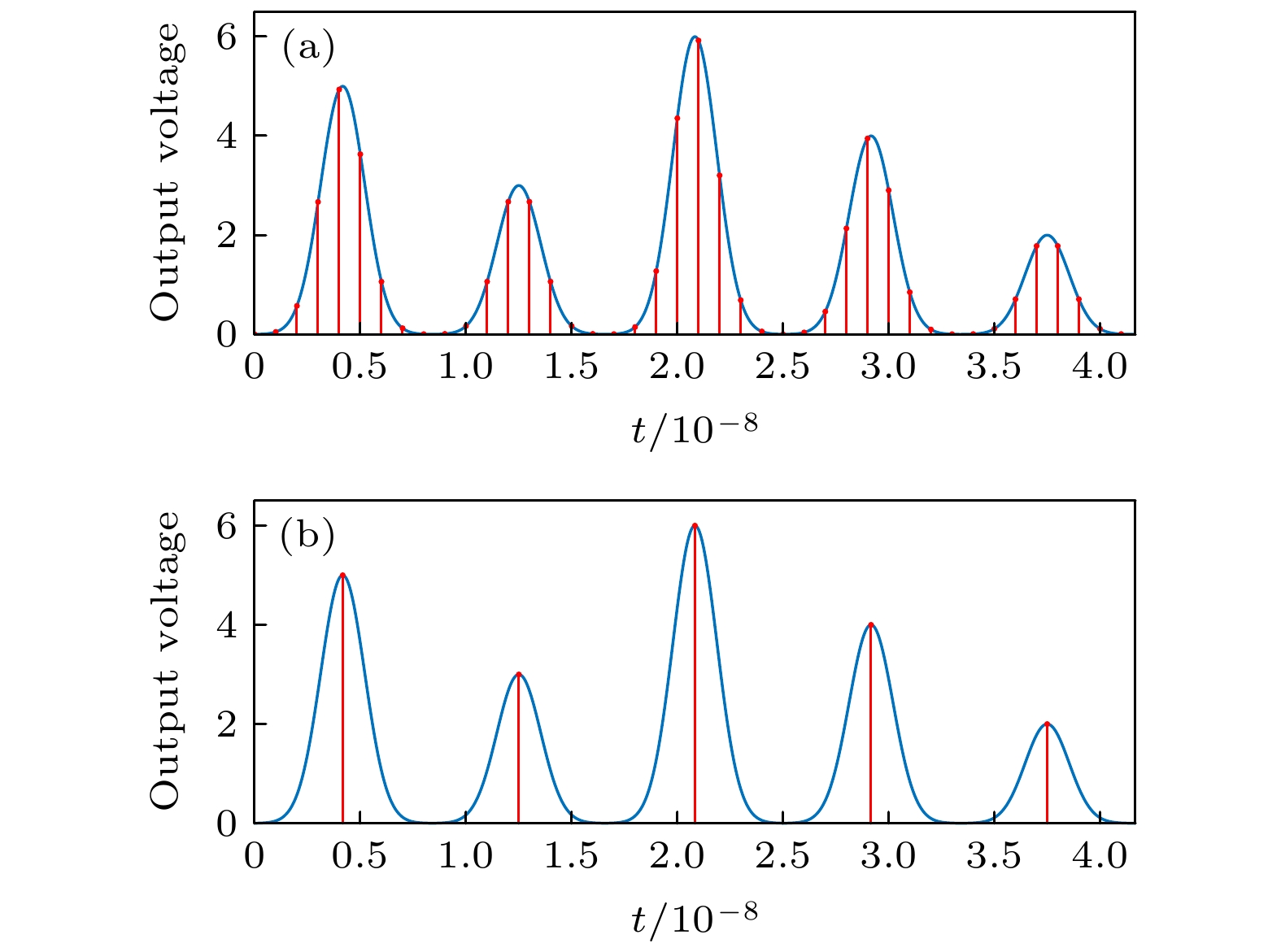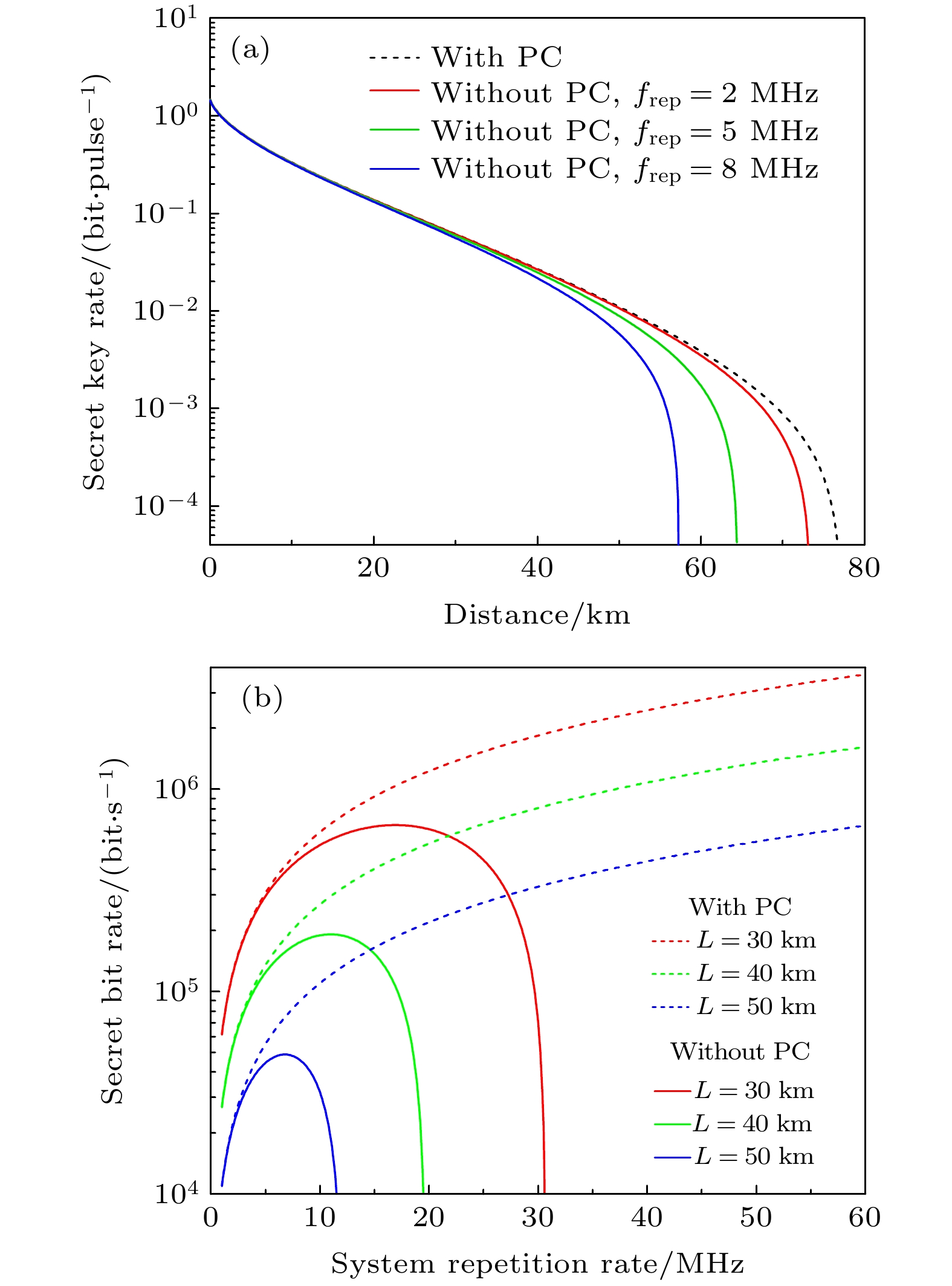-
在实际的连续变量量子密钥分发系统中, 接收端模数转换器的有限采样带宽会导致脉冲峰值采样结果不准确, 从而使参数估计过程产生误差, 给窃听者留下了安全性漏洞. 针对这个问题, 本文提出一种基于峰值补偿的连续变量量子密钥分发方案, 利用高斯脉冲的基本特性来估计每个脉冲的最大采样值与脉冲峰值之间的偏差, 从而对该采样值进行峰值补偿, 使系统得到正确的采样结果. 本文详细分析了有限采样带宽对系统安全性的影响, 阐述了峰值补偿的具体步骤, 并讨论了峰值补偿前后系统估计的过噪声差别, 及其在高斯集体攻击下的安全性. 仿真实验结果表明, 该方案能准确找到每个脉冲的峰值, 纠正系统的参数估计误差. 与不采用峰值补偿的方案相比, 本方案消除了系统重复频率对密钥比特率的限制, 具有更长的安全传输距离和更高的密钥比特率.Continuous-variable quantum key distribution (CVQKD) is an important application of quantum technology, which enables long-distance communicating parties to establish a string of unconditionally secure keys in an insecure environment. However, in a practical CVQKD system, the finite sampling bandwidth of the analog-to-digital converter (ADC) at the receiver may create inaccurate sampling results, leading to errors in parameter estimation process and leaving a security loophole for eavesdroppers. In order to eliminate the finite sampling bandwidth effect, we propose a peak-compensation-based CVQKD scheme, which estimates the discrepancy between the maximum sampling value and the peak value of each pulse based on the characteristics of Gaussian pulse. The maximum sampling values are compensated by the estimated discrepancy, so that the legitimate parties can obtain correct sampling results. We analyze the influence of the finite sampling bandwidth on the security of the system, expounding the specific steps of peak-compensation, comparing the estimated excess noise before and after peak-compensation, and discussing the security of the system under Gaussian collective attacks. Simulation results show that this scheme can greatly improve the accuracy of pulse peak sampling and remove the finite sampling bandwidth effect. Moreover, the channel parameters estimated by the communicating parties are also corrected by using the compensated values. Compared with the scheme without peak-compensation, this scheme eliminates the limitation of the system repetition to the secret key bit rate, and has longer secure transmission distance and higher secret key bit rate. In addition, compared with other methods of solving the finite sampling bandwidth effect, the proposed scheme can be directly implemented in data processing stage after sampling without any additional devices, and thus increasing no complexity of the system.
[1] Yin J, Li Y H, Liao S K, Yang M, Cao Y, Zhang L, Ren J G, Cai W Q, Liu W Y, Li S L, Shu R, Huang Y M, Deng L, Li L, Zhang Q, Liu N L, Chen Y A, Lu C Y, Wang X B, Xu F H, Wang J Y, Peng C Z, Ekert A K, Pan J W 2020 Nature 582 501
 Google Scholar
Google Scholar
[2] Fang X T, Zeng P, Liu H, Zou M, Wu W J, Tang Y L, Sheng Y J, Xiang Y, Zhang W, Li H, Wang Z, You L, Li M J, Chen H, Chen Y A, Zhang Q, Peng C Z, Ma X, Chen T Y, Pan J W 2020 Nat. Photonics 14 422
 Google Scholar
Google Scholar
[3] Wang B X, Mao Y Q, Shen L, Zhang L, Lan X B, Ge D W, Gao Y Y, Li J H, Tang Y L, Tang S B, Zhang J, Chen T Y, Pan J W 2020 Opt. Express 28 12558
 Google Scholar
Google Scholar
[4] Zhang Y, Li Z, Chen Z, Weedbrook C, Zhao Y, Wang X, Huang Y, Xu C, Zhang X, Wang Z, Li M, Zhang X, Zheng Z, Chu B, Gao X, Meng N, Cai W, Wang Z, Wang G, Yu S, Guo H 2019 Quantum Sci. and Technol. 4 035006
 Google Scholar
Google Scholar
[5] Zhang Y, Chen Z, Pirandola S, Wang X, Zhou C, Chu B, Zhao Y, Xu B, Yu S, Guo H 2020 Phys. Rev. Lett. 125 010502
 Google Scholar
Google Scholar
[6] Xu F, Ma X, Zhang Q, Lo H K, Pan J W 2020 Rev. Mod. Phys. 92 025002
 Google Scholar
Google Scholar
[7] Laudenbach F, Pacher C, Fung C-H F, Poppe A, Peev M, Schrenk B, Hentschel M, Walther P, Hübel H 2018 Adv. Quantum Technol. 1 1800011
 Google Scholar
Google Scholar
[8] Ralph T C 1999 Phys. Rev. A 61 010303
 Google Scholar
Google Scholar
[9] Grosshans F, Grangier P 2002 Phys. Rev. Lett. 88 057902
 Google Scholar
Google Scholar
[10] Grosshans F, Cerf N J, Wenger J, Tualle-Brouri R, Grangier P 2003 Quantum Inf. Comput. 3 535
[11] Weedbrook C, Lance A M, Bowen W P, Symul T, Ralph T C, Lam P K 2004 Phys. Rev. Lett. 93 170504
 Google Scholar
Google Scholar
[12] Pirandola S, Mancini S, Lloyd S, Braunstein S L 2008 Nat. Phys. 4 726
 Google Scholar
Google Scholar
[13] Leverrier A, Grangier P 2009 Phys. Rev. Lett. 102 180504
 Google Scholar
Google Scholar
[14] Weedbrook C, Pirandola S, Ralph T C 2012 Phys. Rev. A 86 022318
 Google Scholar
Google Scholar
[15] Usenko V C, Grosshans F 2015 Phys. Rev. A 92 062337
 Google Scholar
Google Scholar
[16] Grosshans F, Cerf N J 2004 Phys. Rev. Lett. 92 047905
 Google Scholar
Google Scholar
[17] Navascués M, Grosshans F, Acín A 2006 Phys. Rev. Lett. 97 190502
 Google Scholar
Google Scholar
[18] García-Patrón R, Cerf N J 2006 Phys. Rev. Lett. 97 190503
 Google Scholar
Google Scholar
[19] Renner R, Cirac J I 2009 Phys. Rev. Lett. 102 110504
 Google Scholar
Google Scholar
[20] Leverrier A, Grosshans F, Grangier P 2010 Phys. Rev. A 81 062343
 Google Scholar
Google Scholar
[21] Leverrier A 2015 Phys. Rev. Lett. 114 070501
 Google Scholar
Google Scholar
[22] Jain N, Anisimova E, Khan I, Makarov V, Marquardt C, Leuchs G 2014 New J. Phys. 16 123030
 Google Scholar
Google Scholar
[23] Jouguet P, Kunz-Jacques S, Diamanti E 2013 Phys. Rev. A 87 062313
 Google Scholar
Google Scholar
[24] Ma X C, Sun S H, Jiang M S, Liang L M 2013 Phys. Rev. A 88 022339
 Google Scholar
Google Scholar
[25] Huang J Z, Weedbrook C, Yin Z Q, Wang S, Li H W, Chen W, Guo G C, Han Z F 2013 Phys. Rev. A 87 062329
 Google Scholar
Google Scholar
[26] Ma X C, Sun S H, Jiang M S, Liang L M 2013 Phys. Rev. A 87 052309
 Google Scholar
Google Scholar
[27] Huang J Z, Kunz-Jacques S, Jouguet P, Weedbrook C, Yin Z Q, Wang S, Chen W, Guo G C, Han Z F 2014 Phys. Rev. A 89 032304
 Google Scholar
Google Scholar
[28] Qin H, Kumar R, Alléaume R 2016 Phys. Rev. A 94 012325
 Google Scholar
Google Scholar
[29] Qin H, Kumar R, Makarov V, Alléaume R 2018 Phys. Rev. A 98 012312
 Google Scholar
Google Scholar
[30] Zheng Y, Huang P, Huang A, Peng J, Zeng G 2019 Opt. Express 27 27369
 Google Scholar
Google Scholar
[31] Liu W, Wang X, Wang N, Du S, Li Y 2017 Phys. Rev. A 96
[32] Wang C, Huang P, Huang D, Lin D, Zeng G 2016 Phys. Rev. A 93 022315
 Google Scholar
Google Scholar
[33] Li H, Wang C, Huang P, Huang D, Wang T, Zeng G 2016 Opt. Express 24 20481
 Google Scholar
Google Scholar
[34] Huang D, Lin D, Wang C, Liu W, Fang S, Peng J, Huang P, Zeng G 2015 Opt. Express 23 17511
 Google Scholar
Google Scholar
[35] Wang C, Huang D, Huang P, Lin D, Peng J, Zeng G 2015 Sci. Rep. 5 14607
 Google Scholar
Google Scholar
[36] Qi B, Huang L L, Qian L, Lo H K 2007 Phys. Rev. A 76 052323
 Google Scholar
Google Scholar
[37] Huang P, Huang J, Wang T, Li H, Huang D, Zeng G 2017 Phys. Rev. A 95 052302
 Google Scholar
Google Scholar
-
图 2 零差探测器输出脉冲的时域波形, 箭头表示采样位置.
${t_{\rm{s}}}$ 为采样间隔,${U_{\rm{p}}}$ 为脉冲的峰值,${U_{\rm{m}}}$ 为最大测量值,${T_0}$ 为脉冲持续时间Fig. 2. Time-domain shape of an output pulse from the balanced homodyne detector.
${t_{\rm{s}}}$ , sampling interval;${U_{\rm{p}}}$ , peak value of the pulse;${U_{\rm{m}}}$ , maximal measurement value;${T_0}$ , duration of each pulse.图 3 (a)有限采样带宽影响下的高斯脉冲时域采样情况; (b)峰值补偿后的采样值. 其中蓝色线表示脉冲时域波形, 红色圆点代表采样值
Fig. 3. (a) Sampling positions of Gaussian pulses effected by finite-sampling bandwidth; (b) sampling values after peak compensation. The blue line represents the time-domain shape of the pulses, and the red dots represent the sampled values.
-
[1] Yin J, Li Y H, Liao S K, Yang M, Cao Y, Zhang L, Ren J G, Cai W Q, Liu W Y, Li S L, Shu R, Huang Y M, Deng L, Li L, Zhang Q, Liu N L, Chen Y A, Lu C Y, Wang X B, Xu F H, Wang J Y, Peng C Z, Ekert A K, Pan J W 2020 Nature 582 501
 Google Scholar
Google Scholar
[2] Fang X T, Zeng P, Liu H, Zou M, Wu W J, Tang Y L, Sheng Y J, Xiang Y, Zhang W, Li H, Wang Z, You L, Li M J, Chen H, Chen Y A, Zhang Q, Peng C Z, Ma X, Chen T Y, Pan J W 2020 Nat. Photonics 14 422
 Google Scholar
Google Scholar
[3] Wang B X, Mao Y Q, Shen L, Zhang L, Lan X B, Ge D W, Gao Y Y, Li J H, Tang Y L, Tang S B, Zhang J, Chen T Y, Pan J W 2020 Opt. Express 28 12558
 Google Scholar
Google Scholar
[4] Zhang Y, Li Z, Chen Z, Weedbrook C, Zhao Y, Wang X, Huang Y, Xu C, Zhang X, Wang Z, Li M, Zhang X, Zheng Z, Chu B, Gao X, Meng N, Cai W, Wang Z, Wang G, Yu S, Guo H 2019 Quantum Sci. and Technol. 4 035006
 Google Scholar
Google Scholar
[5] Zhang Y, Chen Z, Pirandola S, Wang X, Zhou C, Chu B, Zhao Y, Xu B, Yu S, Guo H 2020 Phys. Rev. Lett. 125 010502
 Google Scholar
Google Scholar
[6] Xu F, Ma X, Zhang Q, Lo H K, Pan J W 2020 Rev. Mod. Phys. 92 025002
 Google Scholar
Google Scholar
[7] Laudenbach F, Pacher C, Fung C-H F, Poppe A, Peev M, Schrenk B, Hentschel M, Walther P, Hübel H 2018 Adv. Quantum Technol. 1 1800011
 Google Scholar
Google Scholar
[8] Ralph T C 1999 Phys. Rev. A 61 010303
 Google Scholar
Google Scholar
[9] Grosshans F, Grangier P 2002 Phys. Rev. Lett. 88 057902
 Google Scholar
Google Scholar
[10] Grosshans F, Cerf N J, Wenger J, Tualle-Brouri R, Grangier P 2003 Quantum Inf. Comput. 3 535
[11] Weedbrook C, Lance A M, Bowen W P, Symul T, Ralph T C, Lam P K 2004 Phys. Rev. Lett. 93 170504
 Google Scholar
Google Scholar
[12] Pirandola S, Mancini S, Lloyd S, Braunstein S L 2008 Nat. Phys. 4 726
 Google Scholar
Google Scholar
[13] Leverrier A, Grangier P 2009 Phys. Rev. Lett. 102 180504
 Google Scholar
Google Scholar
[14] Weedbrook C, Pirandola S, Ralph T C 2012 Phys. Rev. A 86 022318
 Google Scholar
Google Scholar
[15] Usenko V C, Grosshans F 2015 Phys. Rev. A 92 062337
 Google Scholar
Google Scholar
[16] Grosshans F, Cerf N J 2004 Phys. Rev. Lett. 92 047905
 Google Scholar
Google Scholar
[17] Navascués M, Grosshans F, Acín A 2006 Phys. Rev. Lett. 97 190502
 Google Scholar
Google Scholar
[18] García-Patrón R, Cerf N J 2006 Phys. Rev. Lett. 97 190503
 Google Scholar
Google Scholar
[19] Renner R, Cirac J I 2009 Phys. Rev. Lett. 102 110504
 Google Scholar
Google Scholar
[20] Leverrier A, Grosshans F, Grangier P 2010 Phys. Rev. A 81 062343
 Google Scholar
Google Scholar
[21] Leverrier A 2015 Phys. Rev. Lett. 114 070501
 Google Scholar
Google Scholar
[22] Jain N, Anisimova E, Khan I, Makarov V, Marquardt C, Leuchs G 2014 New J. Phys. 16 123030
 Google Scholar
Google Scholar
[23] Jouguet P, Kunz-Jacques S, Diamanti E 2013 Phys. Rev. A 87 062313
 Google Scholar
Google Scholar
[24] Ma X C, Sun S H, Jiang M S, Liang L M 2013 Phys. Rev. A 88 022339
 Google Scholar
Google Scholar
[25] Huang J Z, Weedbrook C, Yin Z Q, Wang S, Li H W, Chen W, Guo G C, Han Z F 2013 Phys. Rev. A 87 062329
 Google Scholar
Google Scholar
[26] Ma X C, Sun S H, Jiang M S, Liang L M 2013 Phys. Rev. A 87 052309
 Google Scholar
Google Scholar
[27] Huang J Z, Kunz-Jacques S, Jouguet P, Weedbrook C, Yin Z Q, Wang S, Chen W, Guo G C, Han Z F 2014 Phys. Rev. A 89 032304
 Google Scholar
Google Scholar
[28] Qin H, Kumar R, Alléaume R 2016 Phys. Rev. A 94 012325
 Google Scholar
Google Scholar
[29] Qin H, Kumar R, Makarov V, Alléaume R 2018 Phys. Rev. A 98 012312
 Google Scholar
Google Scholar
[30] Zheng Y, Huang P, Huang A, Peng J, Zeng G 2019 Opt. Express 27 27369
 Google Scholar
Google Scholar
[31] Liu W, Wang X, Wang N, Du S, Li Y 2017 Phys. Rev. A 96
[32] Wang C, Huang P, Huang D, Lin D, Zeng G 2016 Phys. Rev. A 93 022315
 Google Scholar
Google Scholar
[33] Li H, Wang C, Huang P, Huang D, Wang T, Zeng G 2016 Opt. Express 24 20481
 Google Scholar
Google Scholar
[34] Huang D, Lin D, Wang C, Liu W, Fang S, Peng J, Huang P, Zeng G 2015 Opt. Express 23 17511
 Google Scholar
Google Scholar
[35] Wang C, Huang D, Huang P, Lin D, Peng J, Zeng G 2015 Sci. Rep. 5 14607
 Google Scholar
Google Scholar
[36] Qi B, Huang L L, Qian L, Lo H K 2007 Phys. Rev. A 76 052323
 Google Scholar
Google Scholar
[37] Huang P, Huang J, Wang T, Li H, Huang D, Zeng G 2017 Phys. Rev. A 95 052302
 Google Scholar
Google Scholar
计量
- 文章访问数: 7771
- PDF下载量: 88
- 被引次数: 0














 下载:
下载:












